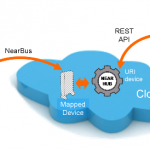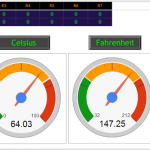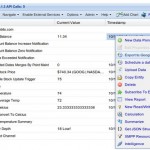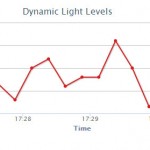GroveStreams is a powerful cloud platform that provides storage and analytics for the Internet of Things, providing Big Data analytics in the cloud and allowing you to capture, analyse and make decisions on data as it arrives. This essentially provides powerful decision-making capabilities to many users and devices and allows you to easily aggregate, visualise and analyse data arriving from many different sensors and data sources.
The included data-streaming analytics are designed to scale to meet your demand for data, so that your business or organisation can quickly react to changes in the data environment – and changes in the physical sensor environment – as those changes are happening. GroveStreams isn’t just built to allow you react to data, it’s also built to allow your devices to react accordingly by using the open, platform independent, GroveStreams API.
The proliferation of devices that generate data in wireless sensor networks, environmental sensing, home and building automation, and Internet-of-Things applications and systems increases every day, and GroveStreams offers a system that can effectively capture, analyse and react to these emerging Big Data sources in a timely manner, with cloud-based scalability and reliability.
GroveStreams is an open cloud-based platform that any organisation, user or device can take advantage of, with an open API and free accounts for low-traffic hobbyist, experimenter or evaluation users. The platform specialises in capturing, analysing and acting on large amounts of time-series data points and streams, with the ability to manage large numbers of different data streams for each organisation.
Each stream can store over 60 million data points or samples, meaning that a stream of sensor data collected once per second can be logged continuously for just under two years in a single continuous data stream.
The GroveStreams platform provides sample timing accurate to the millisecond, and support for many different data types such as integers and floating-point numbers with user-defined physical units, text strings, dates and times and geographic coordinates, along with actionable data analytics such as user-defined roll-ups of data over time, interval gap detection to allow you to monitor the quality and reliability of sensor data streams as they arrive, data streams that are derived from internal or external RSS feeds, calculations and basic statistical processing on data streams, and derived data streams that are derived from arithmetical or statistical operations on other streams of sensor data.
For example, a stream of temperature data in degrees Fahrenheit may be generated by taking another data stream which receives temperature measurements in degrees Celsius from a sensor and applying a mathematical transformation to this stream, or a stream of energy use data from an energy sensor might be multiplied by another stream containing real-time energy pricing information (cents per kilowatt-hour) derived from an RSS feed, allowing an accurate measurement of accumulated energy cost.
GroveStreams provides for the easy aggregation of large numbers of different data streams, and customisable drag-and-drop HTML dashboarding for flexible, customisable dashboarding and visualisation of your data streams, along with live charts and grids which can be embedded within external Web pages, allowing embedding of data displays within external web pages – although they are still served from the GroveStreams cloud infrastructure.

New components and streams can register themselves automatically and appear in existing dashboards and aggregation analytics as they upload their initial feed data, minimising the need for difficult configuration of new components and streams to connect them into existing dashboards or analytics.
All components and streams provide their own RSS feeds, and RSS feeds can be added to your custom dashboards for viewing within the dashboards. It is also possible to configure sensor-driven, data-driven event monitoring with customisable HTTP call, email or SMS notifications – in response to sensor readings and data values, or in response to time-series trends and statistics derived from your data.
GroveStreams also provides Maps functionality, allowing you to spatially map your data from networks of devices that are equipped with GPS or other capability for location awareness. Distances between devices, speeds, and locations can be tracked and mapped, as well as being subject to all the processing techniques applicable to other data streams. And by providing user role-based security, with public/private web UI settings, you can make your organisation accessible to only your users or also to anonymous guest users, with the ability to set guest access rights to control the way that public users work with your data.
Futhermore a RESTful API is provided with almost all the functionality of GroveStreams exposed out via the public API, including fine-grained API access security. Basic examples to get you started with the API are provided for use with Java, Python, and even for use with Ethernet-enabled Arduinos, allowing you to easily get started with cloud data connectivity from your sensors and physical devices.
A fully browser-based user interface is provided, entirely in HTML without plugins such as Flash, allowing flexible, convenient use of the browser interface across all mobile devices such as smartphones and tablets. GroveStreams can even be re-branded as your “own” application provided to your commercial customers, with your own look, feel and brand identity – while all the cloud infrastructure and hosting under the bonnet is handled by GroveStreams.
GroveStreams is free for small users. Large users will only be billed for what they use (the number of transactions, the number of streams, etc). Once a user’s account exceeds the free metric amounts, they will be required to register a credit card with their account. Billing metrics are constantly gathered and can be monitored in an organisation owner’s account page. For users who aren’t organisation owners, it’s free.
Anyone who needs to collect large amounts of time-series data, monitor it, analyse it and react to this data or data from other devices quickly could benefit from connectivity to the GroveStreams service. Whether you want to monitor one data stream from a single source or many more streams from many sources, GroveStreams is likely to be useful for many different users, including utilities, sensor/device driven organisations or businesses that would benefit from near-real-time sensor data collection and analytics in the cloud. With accounts provided completely free for small-scale users, GroveStreams is also an attractive and accessible platform for electronics hobbyists, open-source enthusiasts and Arduino users looking to get started with a cloud service for data storage, analytics and visualisation for networks of Internet-of-Things sensors and devices.
And thus the possibility of harnessing the Internet of Things is made possible once again by a new platform with many possibilties. Here at the LX Group we can partner with you – finding synergy with your ideas and our experience to create final products that exceed your expectations.
To get started, join us for an obligation-free and confidential discussion about your ideas and how we can help bring them to life – click here to contact us, or telephone 1800 810 124.
LX is an award-winning electronics design company based in Sydney, Australia. LX services include full turnkey design, electronics, hardware, software and firmware design. LX specialises in embedded systems and wireless technologies design.
Published by LX Pty Ltd for itself and the LX Group of companies, including LX Design House, LX Solutions and LX Consulting, LX Innovations.





